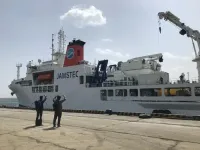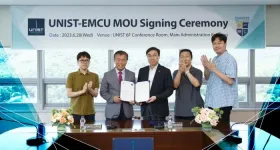(Press-News.org) Researchers in UC Santa Barbara professor Yasamin Mostofi’s lab have proposed a new foundation that can enable high-quality imaging of still objects with only WiFi signals. Their method uses the Geometrical Theory of Diffraction and the corresponding Keller cones to trace edges of the objects. The technique has also enabled, for the first time, imaging, or reading, the English alphabet through walls with WiFi, a task deemed too difficult for WiFi due to the complex details of the letters.
For more details on this technology, check their video at https://www.youtube.com/watch?v=pvqL3gqGDeM
“Imaging still scenery with WiFi is considerably challenging due to the lack of motion,” said Mostofi, a professor of electrical and computer engineering. “We have then taken a completely different approach to tackle this challenging problem by focusing on tracing the edges of the objects instead.” The proposed methodology and experimental results appeared in the Proceedings of the 2023 IEEE National Conference on Radar (RadarConf) on June 21, 2023.
This innovation builds on previous work in the Mostofi Lab, which since 2009 has pioneered sensing with everyday radio frequency signals such as WiFi for several different applications, including crowd analytics, person identification, smart health and smart spaces.
“When a given wave is incident on an edge point, a cone of outgoing rays emerges according to the Keller’s Geometrical Theory of Diffraction (GTD), referred to as a Keller cone,” Mostofi explained. The researchers note that this interaction is not limited to visibly sharp edges but applies to a broader set of surfaces with a small enough curvature.
“Depending on the edge orientation, the cone then leaves different footprints (i.e., conic sections) on a given receiver grid. We then develop a mathematical framework that uses these conic footprints as signatures to infer the orientation of the edges, thus creating an edge map of the scene,” Mostofi continued.
More specifically, the team proposed a Keller cone-based imaging projection kernel. This kernel is implicitly a function of the edge orientations, a relationship that is then exploited to infer the existence/orientation of the edges via hypothesis testing over a small set of possible edge orientations. In other words, if existence of an edge is determined, the edge orientation that best matches the resulting Keller cone-based signature is chosen for a given point that they are interested in imaging.
“Edges of real-life objects have local dependencies,” said Anurag Pallaprolu, the lead Ph.D. student on the project. “Thus, once we find the high-confidence edge points via the proposed imaging kernel, we then propagate their information to the rest of the points using Bayesian information propagation. This step can further help improve the image, since some of the edges may be in a blind region, or can be overpowered by other edges that are closer to the transmitters.” Finally, once an image is formed, the researchers can further improve the image by using image completion tools from the area of vision.
“It is worth noting that traditional imaging techniques result in poor imaging quality when deployed with commodity WiFi transceivers,” added Pallaprolu, “as the surfaces can appear near-specular at lower frequencies, thus not leaving enough signature on the receiver grid.”
The researchers have also extensively studied the impact of several different parameters, such as curvature of a surface, edge orientation, distance to the receiver grid, and transmitter location on the Keller cones and their proposed edge-based imaging system, thereby developing a foundation for a methodical imaging system design.
"We have then taken a completely different approach to tackle this challenging problem by focusing on tracing the edges of the objects instead."
In the team’s experiments, three off-the-shelf WiFi transmitters send wireless waves in the area. WiFi receivers are then mounted on an unmanned vehicle that emulates a WiFi receiver grid as it moves. The receiver measures the received signal power which it then uses for imaging, based on the proposed methodology.
The researchers have extensively tested this technology with several experiments in three different areas, including through-wall scenarios. In one example application, they developed a WiFi Reader to showcase the capabilities of the proposed pipeline.
This application is particularly informative as the English alphabet presents complex details which can be used to test the performance of the imaging system. Along this line, the group has shown how they can successfully image several alphabet-shaped objects. In addition to imaging, they can further classify the letters. Finally, they have shown how their approach enables WiFi to image and read through walls by imaging the details and further reading the letters of the word “BELIEVE” through walls. They have furthermore imaged a number of other objects as well, showing that they can capture details previously not possible with WiFi.
Overall, the proposed approach can open up new directions for RF imaging.
More information about the project can be found at https://web.ece.ucsb.edu/~ymostofi/WiFiReadingThroughWall
Additional information about Mostofi’s research is available at http://www.ece.ucsb.edu/~ymostofi/.
Mostofi can be reached at ymostofi@ece.ucsb.edu.
END
Wifi can read through walls
2023-09-11
ELSE PRESS RELEASES FROM THIS DATE:
Malaria-causing parasites resistant to both treatment and detection have emerged in Ethiopia
2023-09-11
PROVIDENCE, R.I. [Brown University] — Scientists have detected new strains of malaria-causing parasites in Ethiopia that are both resistant to current treatments and escape detection by common diagnostic tests — a development that could increase cases and deaths from malaria and make eliminating the persistent disease an even greater challenge.
The authors detailed their findings from a genomic surveillance study in Nature Microbiology. Already, scientists had found in Uganda, Tanzania and Rwanda strains of the parasite ...
$3.5 million NIH grant funds the first-ever clinical trial of ketone supplementation to treat and or prevent frailty
2023-09-11
The Buck Institute for Research on Aging has received a $3.5 million federal grant to lead the first-ever double-blind, randomized, placebo-controlled clinical trial to understand the effects of ketone ester supplementation on frailty, a condition of vulnerability which develops following age-related decline in multiple physiological systems. TAKEOFF (Targeting Aging with Ketone Ester in Older Adults for Function in Frailty) will recruit a total of 180 people at the Buck, Ohio State University and the University of Connecticut Center on Aging.
“TAKEOFF ...
Scientific ocean drilling discovers dynamic carbon cycling in the ultra-deep-water Japan Trench
2023-09-11
The Japan Trench is located on the “Pacific Ring of Fire”, a region of special interest in earthquake and deep-water research. “It is here that oceanic plates bend, form ultra-deep-water trenches and move below overriding plates in so-called subduction zones, while accumulating long-term global plate tectonic strain”, says Dr. Ken Ikehara from National Institute of Advanced Industrial Science and Technology, Japan, and co-chief scientist of IODP Expedition 386. “This energy is released cataclysmically during so-called megathrust earthquakes, ...
University of Houston researchers charting a sustainable course in oceanic carbon capture
2023-09-11
As researchers around the world race against time to develop new strategies and technologies to fight climate change, a team of scientists at the University of Houston is exploring one possible way to directly reduce the amount of carbon dioxide in the environment: Negative emissions technologies (NETs).
Mim Rahimi, assistant professor of environmental engineering at UH’s Cullen College of Engineering is leading the development of an emerging NET called electrochemical direct ocean capture (eDOC), which helps the ocean cleanse itself of harmful carbon dioxide. The concept ...
Antidepressants may reduce negative memories while improving overall memory, according to Rice study
2023-09-11
New research from Rice University finds that antidepressants may actually reduce negative memories in individuals suffering from depression while improving overall memory function.
The study, “Perceived antidepressant efficacy associated with reduced negative and enhanced neutral mnemonic discrimination,” appears in the latest edition of Frontiers in Human Neuroscience. It examines how antidepressant use in depressed individuals affects memories, both good and bad.
Stephanie Leal, an assistant professor of psychological sciences at Rice, is the study’s lead author. She said the study’s main finding about the link between antidepressants ...
Hybrid catalyst produces critical fertilizer and cleans wastewater
2023-09-11
Agriculture relies on synthetic nitrogen fertilizer, which is made using energy- and carbon-intensive processes and creates nitrate-containing runoff. Researchers have long sought solutions to reduce emissions from the industry that accounts for 3% of energy consumption each year.
A collaboration between two labs at Northwestern University, partnering with the University of Toronto, has found that producing the fertilizer urea using electrified synthesis could both denitrify wastewater while enabling low-carbon-intensity urea production. The process, which includes converting carbon ...
UNIST signs cooperation MoU with Eswatini Medical Christian University
2023-09-11
UNIST has taken a significant step towards combating women’s cancer on the African continent by signing an MOU with Eswatini Medical Christian University (EMCU) on June 28, 2023. The primary purpose of this partnership is to enhance cooperation in the diagnosis and treatment of cervical cancer, marking the beginning of a promising initiative.
Under this agreement, UNIST will lead research and development efforts in cervical cancer diagnosis and treatment technologies, while EMCU will provide a clinical test bed for these advancements.
The ...
OSE Immunotherapeutics announces: positive phase 3 data from its cancer vaccine in lung cancer patients with resistance to previous immunotherapy published in Annals of Oncology
2023-09-11
Nantes, France – September 11, 2023, 6:00pm CET – OSE Immunotherapeutics SA (ISIN: FR0012127173; Mnemo: OSE) today announced the peer-reviewed publication in Annals of Oncology* of the randomized Phase 3 clinical trial (Atalante-1) on T-cell epitope cancer vaccine Tedopi® in HLA-A2 positive patients with advanced or metastatic NSCLC in monotherapy in third line NSCLC with secondary resistance to immune checkpoint inhibitors (ICI).
Tedopi® is a novel T-cell epitope-based cancer vaccine targeting five tumor-associated antigens, ...
Chaplin receives funding for study integrating neural and momentary assessment of parenting, arousal and adolescent substance use
2023-09-11
Tara Chaplin, Associate Professor, Clinical Psychology, received $500,664 from the National Institutes of Health for an Independent Scientist Career Award titled: "Integrating neural and momentary assessment of parenting, arousal, and adolescent substance use."
This Independent Scientist K02 Award will provide Dr. Chaplin with cutting edge advanced training to enhance her career and transform her program of research. Through this training, Dr. Chaplin will integrate ecological momentary assessment (EMA) science into her expertise in developmental neuroscience to understand from a neural and momentary level parenting, emotion, and substance use associations ...
Smith receives funding for watershed programs
2023-09-11
Cynthia Smith, Associate Professor and K12 Education Director, Potomac Environmental Research and Education Center (PEREC), Environmental Science and Policy, received $60,750 from Fairfax County Public Schools for: "FCPS Watershed Programs." This funding began in July 2023 and will end in late June 2024. Since 2010, Smith has worked closely with the FCPS science office to deliver outdoor, hands-on field investigations to 5,200 seventh graders annually. Over 350 Mason students have worked as PEREC field interpreters, honing ...


